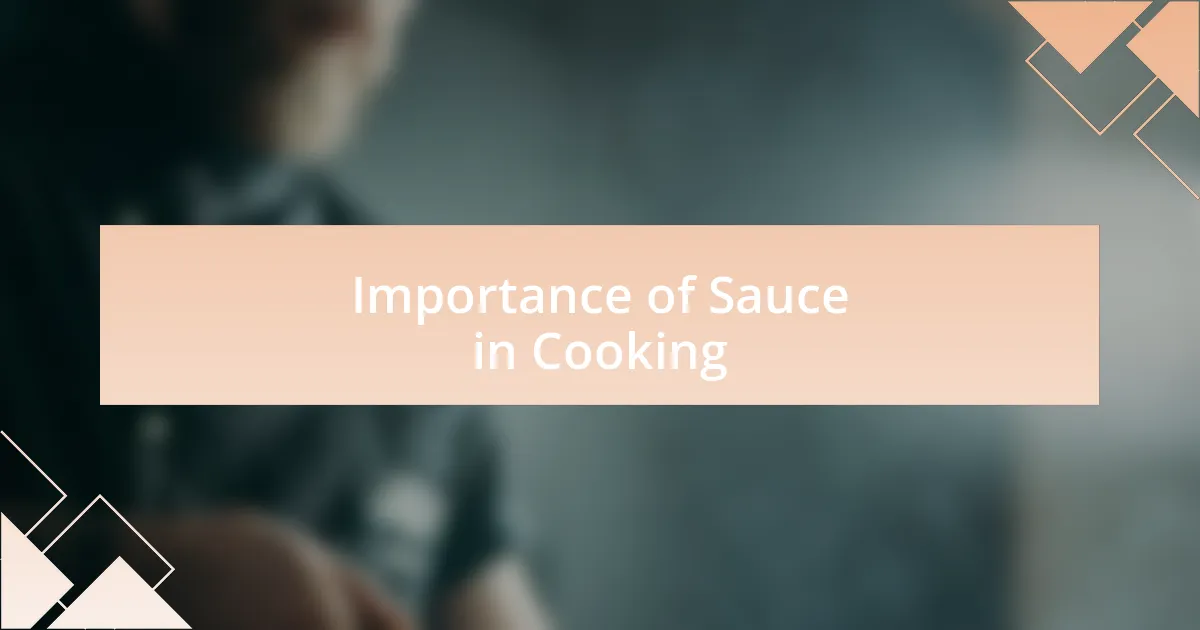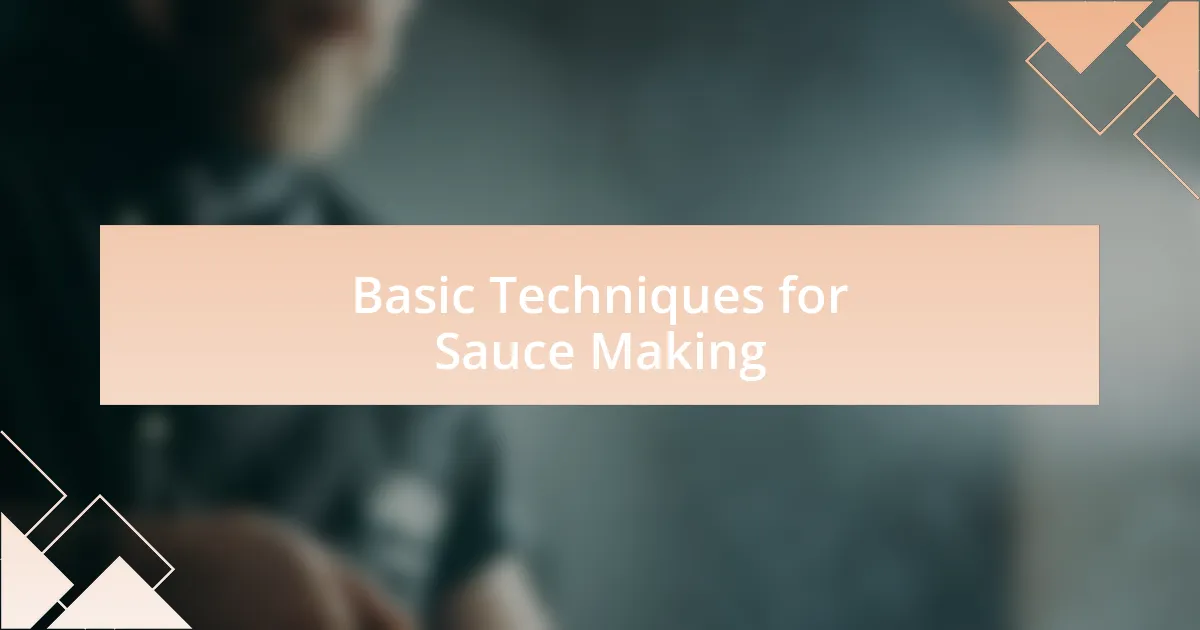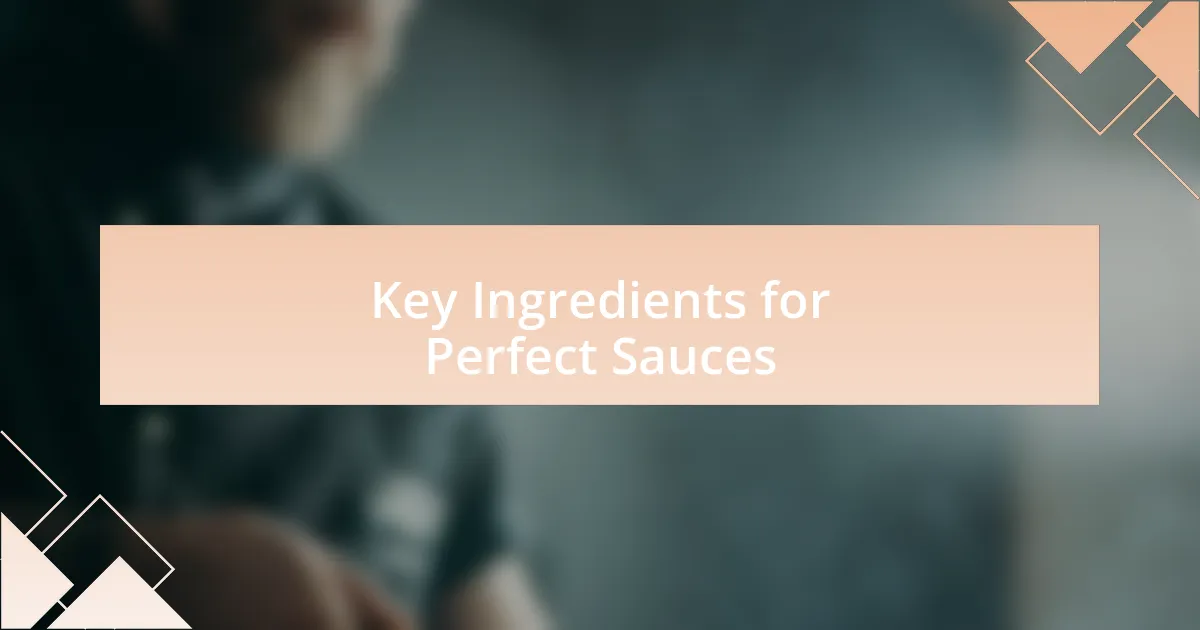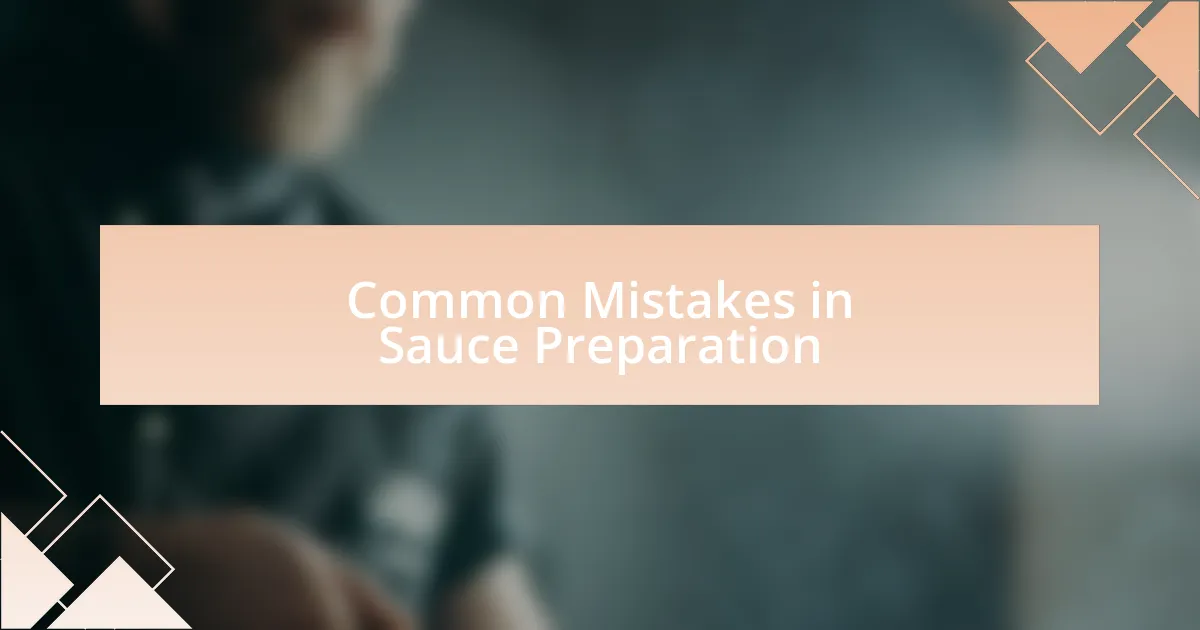Key takeaways:
- Culinary sauces enhance flavors and provide depth, making them essential in cooking.
- Mastering basic techniques like creating a roux and balancing flavors is crucial for successful sauce-making.
- High-quality ingredients, such as rich stocks and proper seasoning, are key to perfect sauces.
- Experimentation with sauces can lead to delightful discoveries and memorable culinary experiences.

Understanding Culinary Sauces
Culinary sauces are often considered the backbone of cooking, enhancing flavors and providing depth to dishes. I remember a time when I experimented with a tomato sauce, unsure of how to balance acidity and sweetness. That process taught me the importance of tasting as you go, a critical skill in sauce-making that allows you to adjust flavors until everything harmonizes beautifully.
Think about it: a well-crafted sauce can elevate even the simplest ingredients into a culinary masterpiece. When I learned to make a basic béchamel, the creamy texture and ability to adapt it into various dishes opened my eyes to the versatility sauces can provide. The lessons I learned from that experience still guide my sauce-making approach today, showing how foundational techniques can lead to endless creativity in the kitchen.
Understanding sauces also involves recognizing the different types, from emulsions like hollandaise to reductions that concentrate flavors. Each type requires careful attention to technique and timing, inviting cooks to engage deeply with their ingredients. Have you ever considered how a simple reduction can transform the essence of a meal? This journey of exploration in sauce-making is as rewarding as it is delicious, inviting you to become one with your culinary creations.

Importance of Sauce in Cooking
Sauces play a pivotal role in cooking, acting as the essential bridge between flavors and textures. I once prepared a classic coq au vin, and it was the rich, wine-based sauce that truly made the dish shine. That experience sparked a realization: without the right sauce, even a well-cooked piece of meat can fall flat, overshadowed by its own simplicity.
Every sauce tells a story, and it’s often a reflection of the ingredients at hand. When I made a fresh pesto from my garden basil, the vibrancy of the herbs infused the dish with life. This taught me that sauces not only enhance flavor but also celebrate seasonal ingredients, connecting us to the culinary landscape around us.
Have you ever experienced a moment when a sauce completely transformed your meal? I have found that a drizzle of a bright citrus vinaigrette can wake up a dull salad, turning it into something vibrant and exciting. This highlights how sauces are more than just complements; they are the key to unlocking a dish’s full potential, inviting us to explore the myriad possibilities of flavor and creativity within our cooking.

Basic Techniques for Sauce Making
When it comes to sauce making, mastering the basic techniques is essential. One of my first lessons was learning to create a roux, a simple blend of flour and fat that serves as the foundation for many sauces. I vividly remember standing in my kitchen, whisking away, and the joy I felt when my béchamel turned creamy and smooth—it was a moment that opened my eyes to the power of a solid base.
Emulsion is another crucial technique. I recall trying to create a hollandaise sauce and struggling until I learned the importance of temperature and patience. Slowly adding melted butter while whisking vigorously transformed my sauce into a velvety delight. It got me thinking about how often we might rush the process in cooking, but a little extra care can lead to extraordinary results.
Lastly, the art of flavor balancing truly elevates your sauces. I often taste my sauces multiple times during preparation, adjusting ingredients like vinegar or salt to create the perfect harmony. This interactive process, where I connect ingredients and my palate, inspires me deeply. Have you ever found that perfect balance that made everything just click? It’s these small adjustments that turn a good sauce into something memorable.

Key Ingredients for Perfect Sauces
The foundation of any great sauce often lies in the choice of ingredients, and the right base can truly change the game. When I first experimented with stock, I was amazed at how its richness could transform a simple sauce into something luxurious. The depth of flavor that a well-made stock provides not only enhances the dish but also elevates the entire dining experience. Have you ever tasted a sauce that lingered on your palate and made you crave that specific flavor again?
Acidity is another crucial component in perfecting sauces. I remember the first time I added a splash of lemon juice to a cream sauce; it was like the dish woke up! That bright note cut through the richness and brought everything together beautifully. It’s fascinating how a little acidity can balance flavors and add complexity, don’t you think? I always encourage home cooks to play with different acid sources, whether it’s vinegar, citrus, or even a splash of wine, to find that magic ratio.
Finally, let’s not forget the impact of seasoning. Salt, in particular, is often underestimated. Early in my cooking journey, I made a fantastic mushroom sauce, but it fell flat until I seasoned it correctly. Adding just the right amount of salt made everything pop, transforming the sauce into a star. It reminds me that seasoning is more than just an afterthought; it’s an integral part of the process that deserves attention and care. Have you ever had a dish that felt incomplete until you seasoned it just right?

My Personal Sauce Recipes
One of my all-time favorite sauce recipes is a classic béchamel with a twist. I like to infuse it with a hint of nutmeg and a bit of sharp cheddar cheese for a creamy comfort that is simply unforgettable. The first time I served it over homemade macaroni, my friends couldn’t believe how a simple white sauce could evoke such joy; it felt like a warm hug on a cold day.
Another gem in my recipe book is a fresh tomato basil sauce that encapsulates the essence of summer. I remember wandering through my garden, picking vine-ripened tomatoes, and tossing them in a pot with a drizzle of olive oil and fragrant basil. The aroma that filled my kitchen was intoxicating, and I still get chills thinking about how that vibrant sauce brightened every dish it touched. Isn’t it amazing how a few fresh ingredients can transport you right back to a memory?
Lastly, I can’t help but share my go-to spicy chili sauce, which I developed after a particularly adventurous trip to Thailand. With a kick of fresh chilies, garlic, and a splash of fish sauce, it adds a bold punch to any meal. I vividly recall the first time I served it at a gathering; the spice hit everyone at the table, sparking lively conversation and laughter. Have you ever made a sauce that not only enhanced your dish but also ignited a shared experience among friends?

Tips for Experimenting with Sauces
When experimenting with sauces, I find that starting with a base you love is essential. For instance, my curiosity once led me to alter a basic marinara by adding a splash of red wine and a hint of dark chocolate. The result was surprisingly rich and complex, proving how simple tweaks can lead to delightful discoveries. Have you tried turning an everyday sauce into something extraordinary?
Another tip I can’t stress enough is to taste as you go. I remember once getting excited and adding too much lemon juice to a garlic sauce. While my initial thought was panic, I quickly grabbed some cream and herbs to balance it out. It transformed into something uniquely delicious! This experience taught me the importance of balance—after all, the right flavors can turn a mistake into a masterpiece.
Additionally, don’t shy away from unconventional ingredients. Once, I was in a pinch and used peanut butter in a soy-based sauce, creating an unexpectedly delightful Asian-inspired dip. That moment reinforced a key lesson: the kitchen is a playground, and being adventurous can lead to new favorites. What unexpected flavors have you combined that surprised you?

Common Mistakes in Sauce Preparation
One of the most common mistakes I see is not allowing enough time for flavors to meld. I recall a time when I was in a rush preparing a quick sauce for pasta. I didn’t let it simmer long enough, thinking it would taste fine. The end result was flat and uninspired—definitely not what I had in mind. Have you ever rushed a sauce and regretted it later?
Another frequent error is neglecting to season properly. I’ve had moments where I focused solely on the technique, only to forget the salt. A lack of seasoning can leave a sauce tasting bland, making all that effort feel wasted. Balancing flavors is crucial; it can elevate even the simplest sauces. Have you ever tasted something that seemed appealing but lacked that zing?
Finally, failing to pair the sauce with the right dish can be a real downer. I remember creating a rich béchamel that I thought would be perfect with grilled vegetables, but it overwhelmed the delicate flavors instead. It taught me that sauces need to complement their partners on the plate. How do you choose which sauce to pair with your dishes?